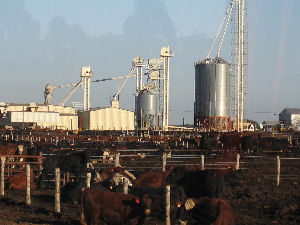What is an EMS?
Environmental Management Systems (EMS) are a method of improving environmental and economic performance of a firm. They are widely accepted across many industries and are increasingly common in agriculture. An EMS is a process for integrating environmental considerations and requirements into day-to-day management and long-term planning for a farm.
This management approach examines a production system from start to finish, from inputs to products. With an EMS, the owner/operator and employees develop a plan for action that fits specific needs and resources, builds upon their stewardship principles, helps comply with legal requirements, and works to continually improve the operation. Also see What is an Ag EMS?
An EMS does NOT replace regulations, but may help in attaining compliance or realizing other benefits related to reduced environmental liability and better management. The EPA encourages adoption of EMS’s as a method of improve regulatory compliance, encourage environmental performance, and perhaps reduce regulatory burden.
An emerging concept that is very similar to an EMS is known as ‘adaptive management’. Check out an archived webinar on Adaptive Nutrient Management and a recorded symposium presentation on opportunities for adaptive grazing management in drought-stricken areas.
The EMS process was developed for industry and is commonplace in manufacturing world wide. The most recognized system is ISO 14001 which involves third party certification and formal auditing. As farms become larger and more complex and rely on more employees and outsource more services, the farmer needs a systematic method of managing his or her operation. While formal certification may not be necessary, the EMS process and principles can help farmers improve their environmental and economic performance. There are Ag EMS Publications tailored for agriculture that make it practical to implement on the farm.
The EMS model is a Plan, Implement, Check and Correct, and Review sequence, a proven successful management process. The planning process begins with establishing an environmental policy for the farm/ranch that describes the farmer’s commitment to environmental stewardship, to meeting regulations, and to continual improvement.
Environmental Policy Statement
An EMS policy statement describes the environmental principles that are important to you, and establishes your goals for managing them. Everyone who works on your farm should know and share a commitment to the policy statement. You can showcase this statement to the public to demonstrate your environmental commitment. An EMS policy statement should at a minimum describe your commitment to:
-
- pollution prevention,
- continual improvement, and
- compliance with environmental regulation.
Plan
Next, the farmer assesses the current operation to identify strengths and weaknesses and identifies which if any are causing significant environmental concerns. He or she has now identified a small list of priorities to address first. Then, an action plan with defined objectives, measurable outcomes, and specific steps, timelines, and assignments is developed for each priority. Some assessments can be found at:
Implement
“Implement” involves communicating the plan to the people that are responsible for making it happen. This includes preparing operating procedures, training, and resources as needed.
Check
“Check” is a regular review of the plan’s progress and environmental performance. If problems arise “Correct” refers to corrective actions taken. Documenting regular monitoring actions taken helps the farmer measure progress and shows a proactive approach to environmental improvement.
Review
“Review” closes the loop on the continuous improvement process. Farmers annually review their operation and their plan to determine if they are headed in the right direction, using the best methods, and making progress.
Chances are good that components of the EMS process are already being utilized on a farm. These may include management plans for manure handling, pests, or nutrients, in addition to records on soil testing, chemical applications, feeding requirements, or worker training. An EMS helps organize and document these efforts and improve the environmental and economic performance of the farm.
Examples of Environmental Management Systems for Agriculture
-
- Michigan Agricultural Environmental Assurance Program (MAEAP)
- North Carolina Pork Environmental Management Systems project
- Iowa Soybean Association Certified Environmental Management Systems for Agriculture (CEMSA) is a farmer-led program that is designed to help farmers incorporate an EMS within their farming operation.
- EPA maintains a summary of EMS related programs
Resources For More Information
Author: John Lawrence, Iowa State University Reviewers: Mark Risse, University of Georgia and Tommy Bass, Montana State University



